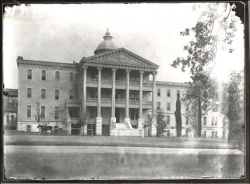Austin State Hospital
| Austin State Hospital | |
|---|---|
 | |
| Established | 1856 |
| Construction Began | 1857 |
| Construction Ended | 1861 |
| Current Status | Active |
| Building Style | Kirkbride Plan |
| Peak Patient Population | 3,665 in 1960 |
| Alternate Names |
|
History
Austin State Hospital was the first state facility of its kind built west of the Mississippi. In 1856, the governor of Texas signed a bill providing for the establishment of the Texas State Lunatic Asylum. Construction started in 1857, and the first patients were admitted in 1861. The facility was renamed the Austin State Hospital (ASH) in 1925.
Today, this original building serves as the administration building for a modern, innovative facility providing psychiatric care to a 38-county region in Central Texas. ASH admitted over 4400 patients in the fiscal year 2006, with about the same number of discharges, and has an average daily patient census of 292. The focus of treatment is stabilization of acute psychiatric illness and return to the community.
The old Texas State Lunatic Asylum, which now houses the administrative staff of the Austin State Hospital, is the third oldest standing public building our state. With its completion in 1861 in the lush countryside north of Austin, the hospital stood as a beacon of hope and tolerance for the treatment of the mentally ill.
The asylum movement in the United States and Europe reflected the belief that people recently diagnosed with mental ailments could regain their sanity in an idealized environment free from the stress of everyday life. Asylums strived to provide a healthy diet, exercise, fresh air, adequate rest, a strict daily routine, social contact, and a kind but firm approach. This humanitarian philosophy marked a vast leap forward from earlier theories that mental illness stemmed from demonic possession and proscribed treatments such as flogging and cold water to drive out the demons. Texas modeled its asylum after an innovative program developed in Philadelphia by Dr. Thomas Kirkbride. The Philadelphia maverick had pioneered new, progressive treatments for the mentally insane, including behavior modification, drug therapy and an unrestrictive environment.
The lunatic asylum, later renamed the Austin State Hospital in 1925, strived to offer patients the most modern treatments, including art, music, and recreational therapy. It also provided state-of-the-art medical care, such as psychiatric drugs, hydrotherapy, electroconvulsive shock treatment, and on rare occasions, surgical lobotomy. From 1904-1928, the asylum also housed the Pasteur Institute, which provided rabies shots to afflicted Texans. Visitors to the administration building can view intriguing medical artifacts.
The original building, which was dressed up with a classical portico in 1904, offered three stories and a basement for administrative offices and staff and patient quarters. Its thick, hard plaster walls could endure frequent scrubbing and the thick limestone walls and high ceilings offered relief from the Texas heat. Noisy patients were separated from quiet ones, and all patients lived above ground in rooms with at least one window. As the patient population grew from the initial 12 patients to nearly 700 by the late 1890's, additional wings and buildings sprang up. The asylum functioned as a self-supporting village with artesian wells, gardens, a dairy, ice factory, and a sewing/tailor shop. These other historic structures were eventually destroyed by fire or demolished to make way for newer buildings.
Early residents of Hyde Park were drawn to the expansive landscaped asylum grounds, taking carriage rides on the 700 yards of graveled drives and enjoying picnics under the live oak trees and along the banks of lily ponds. Children of the era explored the Japanese-style gardens and paddled small boats to the tiny islands dotting the large lake on the southeastern corner of the property.
While a sense of timelessness pervaded the beautiful fenced grounds, the hospital nonetheless felt the impact of the passing years. So many attendants fell ill or fled with fear during the devastating 1918 influenza epidemic that patients had to run the wards. World War II brought personnel and food shortages. Racial integration began in 1958, ending the practice of separating black patients into inferior quarters. The new emphasis on personal freedom championed by the civil rights movement helped fuel the community care movement, eventually emptying the beds of the Austin State Hospital and other institutions.
The Austin State Hospital, which once housed more than 3,000 patients during the 1960's, currently serves as an acute care facility for its 300 patients. Patients typically stay several days to a few weeks until their condition stabilizes and they can return to their communities. The focus of treatment is stabilization of acute psychiatric illnesses and return to the community where outpatient support services can be provided by the community centers that work with ASH.[1]
Images of Austin State Hospital
Main Image Gallery: Austin State Hospital
Books
- Life at the Texas State Lunatic Asylum, 1857–1997, by Sarah C. Sitton
Cemetery
The current cemetery opened in 1882, making it 25 years “newer” than the state hospital, which dates to 1857. During those 25 years, deceased patients were buried in a small on-campus graveyard. Their remains have since been moved to the new cemetery. The current cemetery has about 3,000 patients buried within, most unmarked. The cemetery still is used today, serving both the Austin State Hospital and Austin State School.

